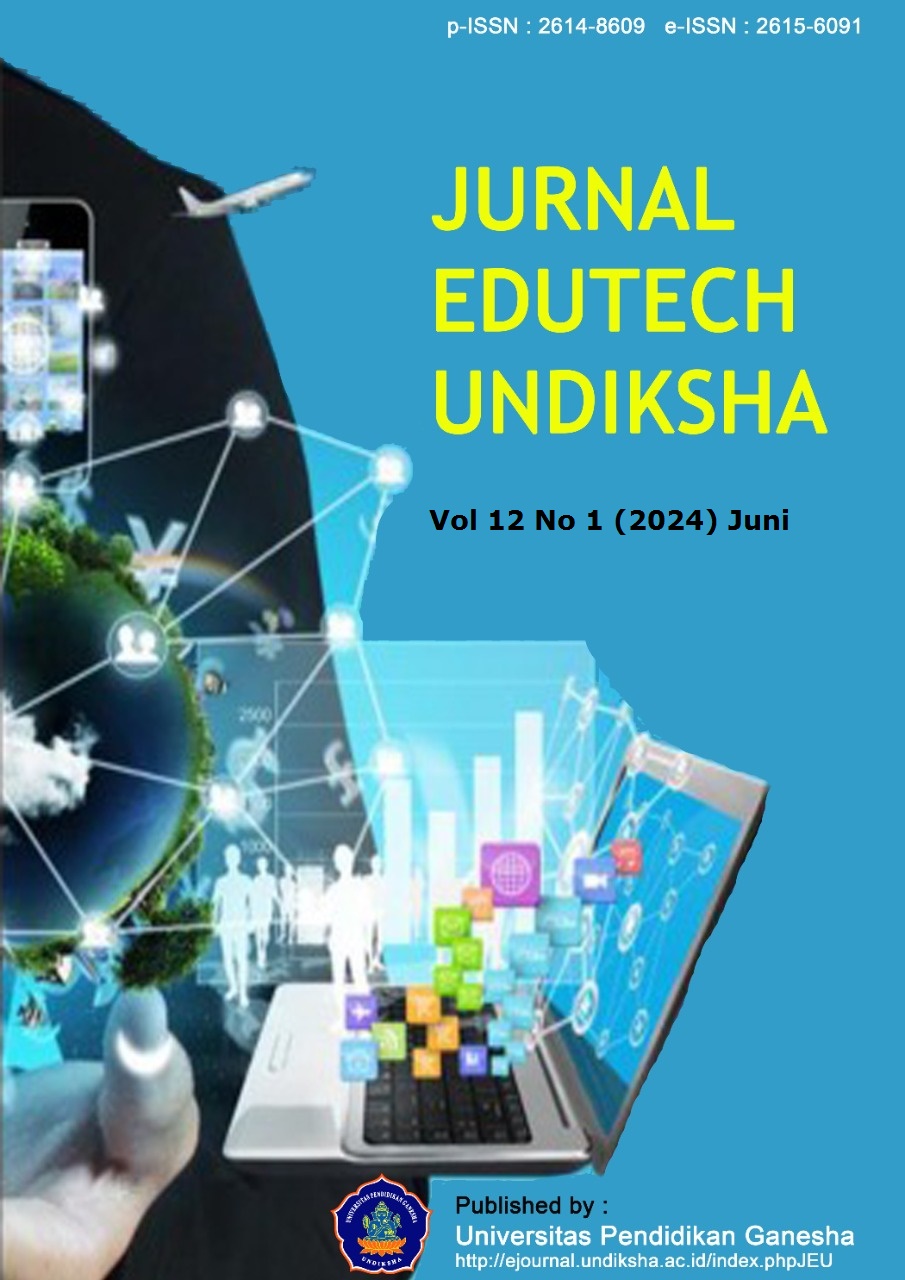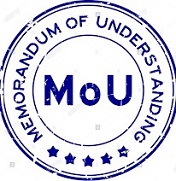Importance-Performance Analysis of SINERGI UPI Website User Satisfaction
DOI:
https://doi.org/10.23887/jeu.v12i1.64450Keywords:
Dynamic archive, Importance Performance Analysis, user satisfaction, website assessmentAbstract
SINERGI UPI is a dynamic archive management system at Universitas Pendidikan Indonesia (UPI). The use of SINERGI within UPI needs to be pursued for optimal management of dynamic archives. One thing that needs to be considered is the user satisfaction component to create a good impression for the academic community as SINERGI users. This research was conducted to analyze SINERGI from the aspect of user satisfaction. The research uses a quantitative approach with survey methods. The survey was conducted among study program staff within the Faculty of Educational Sciences UPI who actively use SINERGI, namely thirteen people. The data analysis technique uses Importance-Performance Analysis (IPA). The research results illustrate that all indicators fall into quadrant II: Keep up the good work. This shows that the SINERGI user satisfaction of the FIP UPI academic community is satisfied with the SINERGI facilities, and it is hoped that it will be even better in the future. However, there are hopes and suggestions for improvements for the future development of the SINERGI website, namely in the menu bar and notifications. Some staff expect an additional menu, namely notifications sent via email or WhatsApp. This is to make it easier when there is an incoming letter notification so that the staff can respond immediately. There is also another proposal in the form of a follow-up workshop related to using SINERGI at a higher level.
References
Alfian, A. N., Putra, M. Y., Arifin, R. W., Barokah, A., Safei, A., & Julian, N. (2022). Pemanfaatan Media Pembelajaran Audio Visual berbasis Aplikasi Canva. Jurnal Pengabdian Kepada Masyarakat UBJ, 5(1), 75–84. https://doi.org/10.31599/jabdimas.v5i1.986. DOI: https://doi.org/10.31599/jabdimas.v5i1.986
Ariono, B., Wasesa, M., & Dhewanto, W. (2022). The Drivers, Barriers, and Enablers of Building Information Modeling (BIM) Innovation in Developing Countries: Insights from Systematic Literature Review and Comparative Analysis. Buildings, 12(11), 1-22. https://doi.org/10.3390/buildings12111912. DOI: https://doi.org/10.3390/buildings12111912
Bahadur, G. K., & Boodun, S. S. (2013). Using powerpoint presentations as a tool for effective teaching and learning of water science for upper primary pupils in mauritius. International Journal of Science, Mathematics and Technology Learning, 19(2), 65–78. https://doi.org/10.18848/2327-7971/cgp/v19i02/48988. DOI: https://doi.org/10.18848/2327-7971/CGP/v19i02/48988
Bentlage, E., Ammar, A., Chtourou, H., Trabelsi, K., How, D., Ahmed, M., & Brach, M. (2020). Practical recommendations for staying physically active during the COVID-19 pandemic: A systematic literature review. MedRxiv, 17(Aug), 1–22. https://doi.org/10.1101/2020.06.24.20138313. DOI: https://doi.org/10.1101/2020.06.24.20138313
Challob, A. I. (2021). The effect of flipped learning on EFL students’ writing performance, autonomy, and motivation. Education and Information Technologies, 26(4), 3743–3769. https://doi.org/10.1007/s10639-021-10434-1. DOI: https://doi.org/10.1007/s10639-021-10434-1
Desnanjaya, I. G. M. N., & Nugraha, I. M. A. (2021). Design and Control System of Sluice Gate With Web-Based Information. 2021 International Conference on Smart-Green Technology in Electrical and Information Systems (ICSGTEIS), 52–57. https://doi.org/10.1109/ICSGTEIS53426.2021.9650409. DOI: https://doi.org/10.1109/ICSGTEIS53426.2021.9650409
Duklim, B., & Musigrungsi, S. (2018). Oral presentation performance and strategies employed by students in an international classroom context. Songklanakarin Journal of Social Sciences and Humanities, 24(1), 39–74. https://so05.tci-thaijo.org/index.php/psujssh/article/view/127909.
Gormally, C., Brickman, P., & Lutz, M. (2012). Developing a Test of Scientific Literacy Skills (TOSLS): Measuring Undergraduates’ Evaluation of Scientific Information and Arguments. CBE Life Sciences Education, 11(4), 364–377. https://doi.org/10.1187/cbe.12-03-0026. DOI: https://doi.org/10.1187/cbe.12-03-0026
Gultom, R. (2018). Analisis Penggunaan Alat Pelindung Diri ( APD ) dalam Keselamatan dan Kesehatan Kerja ( K3 ) Proyek Kontruksi di PT . Eka Paksi Sejati . Studi Kasus : Proyek Kontruksi untuk Pemboran Sumur EksploirasiTitanum ( TTN-001 ) Daerah Aceh Tamiang. Jurnal Bisnis Corporate, 3(1), 92–124. https://doi.org/10.46576/jbc.v3i1.377.
Hamdani, M. S., Wardani, M., & Widi, K. (2019). Penerapan Model Pembelajaran Team Games Tournamen (TGT) pada Pembelajaran Tematik Terpadu Kelas 5 untuk Peningkatan Keterampilan Kolaborasi. Jurnal Ilmiah Sekolah Dasar, 3(4), 440. https://doi.org/10.23887/jisd.v3i4.21778. DOI: https://doi.org/10.23887/jisd.v3i4.21778
Hoesny, M. U., & Darmayanti, R. (2021). Permasalahan dan Solusi Untuk Meningkatkan Kompetensi dan Kualitas Guru : Sebuah Kajian Pustaka. Scholaria : Jurnal Pendidikan Dan Kebudayaan, 11(2), 123–132. https://ejournal.uksw.edu/scholaria/article/view/3595.
Lesva, O., & Arif, A. (2020). Sistem Informasi Wisata Purbakala Situs Megalithikum Kota Pagaralam, Sumatera Selatan. JUSIM (Jurnal Sist. Inf. Musirawas), 5(2), 111–123. http://download.garuda.kemdikbud.go.id/article.php?article=2104834&val=15085. DOI: https://doi.org/10.32767/jusim.v5i02.1034
Luo, Z., Brown, C., & O’Steen, B. (2021). Factors contributing to teachers’ acceptance intention of gamified learning tools in secondary schools: An exploratory study. Education and Information Technologies, 26(5), 6337–6363. https://doi.org/10.1007/s10639-021-10622-z. DOI: https://doi.org/10.1007/s10639-021-10622-z
Magalhaes, A. D., Sopwandin, I., & Bakri, A. A. (2023). Online training application design with website-based blended learning system method. Journal of Information System, Technology and Engineering, 1(2), 43–48. https://doi.org/10.61487/jiste.v1i2.19. DOI: https://doi.org/10.61487/jiste.v1i2.19
Mazloumi, A., Mehrdad, R., Kazemi, Z., Vahedi, Z., & Hajizade, L. (2021). Risk Factors of Work Related Musculoskeletal Disorders in Iranian Workers during 2000-2015. Journal of Health and Safety at Work, 11(3), 395–416. https://dl.hsenk.ir/uploads/2022/08/HSEnk-1558.pdf.
Mentzakis, E., Tkacz, D., & Rivas, C. (2020). A proof-of-concept framework for the preference elicitation and evaluation of health informatics technologies: The online PRESENT patient experience dashboard as a case example. BMC Medical Informatics and Decision Making, 20(1). https://doi.org/10.1186/s12911-020-1098-z. DOI: https://doi.org/10.1186/s12911-020-1098-z
Mouakket, S., & Sun, Y. (2020). Investigating the Impact of Personality Traits of Social Network Sites Users on Information Disclosure in China: the Moderating Role of Gender. Information Systems Frontiers, 22(6), 1305–1321. https://doi.org/10.1007/s10796-019-09933-x. DOI: https://doi.org/10.1007/s10796-019-09933-x
Mubyl, M., & Dwinanda, G. (2019). Peran subjective well-being , kepemimpinan transformasional dan komitmen organisasional dalam memprediksi kinerja karyawan. Jurnal Bisnis & Kewirausahaan, 8(1), 74–85. http://e-jurnal.nobel.ac.id/index.php/jbk/article/view/502.
Ofei, A. M. A., Paarima, Y., & Barnes, T. (2020). Exploring the management competencies of nurse managers in the Greater Accra Region, Ghana. International Journal of Africa Nursing Sciences, 13(September 2020), 100248.1-7. https://doi.org/10.1016/j.ijans.2020.100248. DOI: https://doi.org/10.1016/j.ijans.2020.100248
Oláh, J., Aburumman, N., Popp, J., Khan, M. A., Haddad, H., & Kitukutha, N. (2020). Impact of industry 4.0 on environmental sustainability. Sustainability (Switzerland), 12(11), 1–17. https://doi.org/10.3390/su12114674. DOI: https://doi.org/10.3390/su12114674
Razzano, M., Di Renzo, F., Fidecaro, F., Hemming, G., & Katsanevas, S. (2023). GWitchHunters: Machine learning and citizen science to improve the performance of gravitational wave detector. Nuclear Instruments and Methods in Physics Research, Section A: Accelerators, Spectrometers, Detectors and Associated Equipment, 1048, 167959. https://doi.org/10.1016/j.nima.2022.167959. DOI: https://doi.org/10.1016/j.nima.2022.167959
Riyanto, A. D. (2015). Pembuatan Website Sebagai Media Promosi Yang Terpercaya. In Seminar Nasional Informatika (SEMNASIF). http://103.23.20.161/index.php/semnasif/article/view/1362.
Rohmah, F. N., & Bukhori, I. (2020). Pengembangan Media Pembelajaran Interaktif Mata Pelajaran Korespondensi Berbasis Android Menggunakan Articulate Storyline 3. ECOEDUCATION (Economic & Education Journal), 2(2), 169–182. https://doi.org/10.33503/ecoducation.v2i2.892. DOI: https://doi.org/10.33503/ecoducation.v2i2.892
Rosidin, U., Herpratiwi, Suana, W., & Firdaos, R. (2019). Evaluation of National Examination (UN) and National-Based School Examination (USBN) in Indonesia. European Journal of Educational Research, 8(3), 827–837. https://doi.org/10.12973/eu-jer.8.3.827. DOI: https://doi.org/10.12973/eu-jer.8.3.827
Saurik, H. T. T., Purwanto, D. D., & Hadikusuma, J. I. (2019). Teknologi Virtual Reality untuk Media Informasi Kampus. Jurnal Teknologi Informasi Dan Ilmu Komputer, 6(1), 71. https://doi.org/10.25126/jtiik.2019611238. DOI: https://doi.org/10.25126/jtiik.2019611238
Sedrakyan, G., Malmberg, J., Verbert, K., Järvelä, S., & Kirschner, P. A. (2020). Linking learning behavior analytics and learning science concepts: Designing a learning analytics dashboard for feedback to support learning regulation. Computers in Human Behavior, 107, 105512. https://doi.org/10.1016/j.chb.2018.05.004. DOI: https://doi.org/10.1016/j.chb.2018.05.004
Seixas, B. V., Smith, N., & Mitton, C. (2018). The qualitative descriptive approach in international comparative studies: Using online qualitative surveys. International Journal of Health Policy and Management, 7(9), 778–781. https://doi.org/10.15171/ijhpm.2017.142. DOI: https://doi.org/10.15171/ijhpm.2017.142
Shahid, C., Abbasi, I. A., & Bhutto, S. (2022). Improving Communicative Competence through CLT Approach in Second Language Learning at the Undergraduate Level. Pakistan Journal of Humanities and Social Sciences, 10(4), 1472–1486. https://doi.org/10.52131/pjhss.2022.1004.0305. DOI: https://doi.org/10.52131/pjhss.2022.1004.0305
Supandi, M., & Senam, S. (2019). Mengembangkan keterampilan berpikir kritis dengan game ritual tumpe. Jurnal Inovasi Pendidikan IPA, 5(2), 139–146. https://doi.org/10.21831/jipi.v5i2.25920. DOI: https://doi.org/10.21831/jipi.v5i2.25920
Suryana, A., Karim, A. A., & Sapriya, S. (2018). Manajemen Capacity Building Tenaga Administrasi Sekolah Di Sekolah Laboratorium Upi. Pedagogia, 15(3), 250265. https://doi.org/10.17509/pdgia.v15i3.11021. DOI: https://doi.org/10.17509/pdgia.v15i3.11021
Virvou, M., Katsionis, G., & Manos, K. (2005). Combining Software Games with Education: Evaluation of its Educational. Educational Technology & Society, 8(2), 54–65. https://www.jstor.org/stable/pdf/jeductechsoci.8.2.54.pdf.
Welch, C., & Piekkari, R. (2017). How should we (not) judge the ‘quality’ of qualitative research? A re-assessment of current evaluative criteria in International Business. Journal of World Business, 52(5), 714–725. https://doi.org/10.1016/j.jwb.2017.05.007. DOI: https://doi.org/10.1016/j.jwb.2017.05.007
Wendel, A. C. (2020). An Exploration of the Numeracy Skills Required for Safe, Quality Nursing Practice. In ProQuest Dissertations and Theses.
Xiao, Y., Han, J., Koenig, K., Xiong, J., & Bao, L. (2018). Multilevel Rasch modeling of two-Tier multiple choice test: A case study using Lawson’s classroom test of scientific reasoning. Physical Review Physics Education Research, 14(2). https://doi.org/10.1103/PhysRevPhysEducRes.14.020104. DOI: https://doi.org/10.1103/PhysRevPhysEducRes.14.020104
Yuniarti, Y., Yulian, R., & Yuniarti, Y. (2022). Digital Story Telling Based on Multimodal Elements on EFL Learners’ Speaking Performance. JPI (Jurnal Pendidikan Indonesia), 11(2), 308–316. https://doi.org/10.23887/jpiundiksha.v11i2.40217. DOI: https://doi.org/10.23887/jpiundiksha.v11i2.40217
Downloads
Published
How to Cite
Issue
Section
License
Copyright (c) 2023 Linda Setiawati, Angga Hadiapurwa, Budi Santoso, Hafsah Nugraha, Ridha Pratama Rusli

This work is licensed under a Creative Commons Attribution-ShareAlike 4.0 International License.
Authors who publish with the Jurnal Edutech Undiksha (JEU) agree to the following terms:
- Authors retain copyright and grant the journal the right of first publication with the work simultaneously licensed under an Attribution-ShareAlike 4.0 International (CC BY-SA 4.0) that allows others to share the work with an acknowledgment of the work's authorship and initial publication in this journal.
- Authors are able to enter into separate, additional contractual arrangements for the non-exclusive distribution of the journal's published version of the work (e.g., post it to an institutional repository or publish it in a book), with an acknowledgment of its initial publication in this journal.
- Authors are permitted and encouraged to post their work online (e.g., in institutional repositories or on their website) prior to and during the submission process, as it can lead to productive exchanges, as well as earlier and greater citation of published work. (See The Effect of Open Access)








